- Calendar
- Online Ticket Sales
- Access
- JA
- EN
Koyasan 1200th Anniversary
Treasures of the Sacred Mountain
October 11 to December 7 2014
*There will be an exhibition change during the course of exhibition
1.- Koyasan and the Life of Kukai
Koyasan will soon celebrate the 1200-year anniversary of its founding by Kukai (Kobo Daishi).
In 797 (Enryaku 16), at the age of 24, Kukai wrote Roko shiiki (Teachings for the Deaf and Blind) and immersed himself in Buddhist study, joining an envoy of monks traveling to Tang China. There, he completed formal transmission of the latest secret teachings of Esoteric Buddhism of the time under master Huiguo. After returning to Japan, he worked toward the establishment and spread of Esoteric Buddhism with Takaosanji (now Jingoji), a temple close to ancient Kyoto, as his base of operations.
He also gained the deep trust of Emperor Saga.
Meanwhile, Kukai searched for a place to pursue ascetic training in the cool of the deep mountains away from the everyday world. Finally, in 816 (Konin7), he requested and was granted permission from the court to establish a base of training for Esoteric Buddhism at Koyasan. From that time forward, this served as the central point from which Kukai spread his teachings throughout Japan, creating a solid footing for Esoteric Buddhism. On 3.21.835 (Jowa2), at the age of 62, he passed into eternal meditation in the Okunoin at Koyasan.
This section presents various treasures related to the founding of Koyasan and relics of Kukai that have been passed down at Koyasan, including the National Treasure Niche with Various Buddha Figures, which he received from Huiguo as evidence of his rightful succession to the Esoteric teachings.
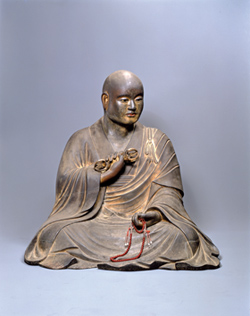
Seated Figure of Kobo Daishi (Mannichi
Daishi)
Muromachi-Momoyama period, 16th-17th century
Kongobuji

National Treasure
Roko shiiki (Teachings for the Deaf and Blind)
By Kukai
Pair of handscrolls
Heian period, 8th-9th century
Kongobuji
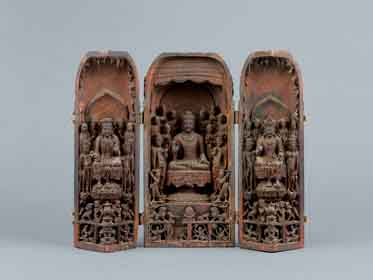
National Treasure
Niche with Various Buddha Figures
China, Tang Dynasty, 8th century
Kongobuji
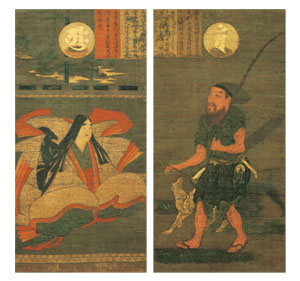
Important Cultural Property
Local Deities of Koyasan: Niu Myojin and
Kariba Myojin
Pair of hanging scrolls
Kamakura period, 13th century
Kongobuji
2.- Esoteric Deities of Koyasan
Kukai asserted that the Esoteric teachings were cryptic and therefore difficult to understand by relying solely on textual materials such as sutras and critical commentaries. Therefore, he advocated the use of paintings and sculpture to facilitate understanding. As a result, once Kukai began to transmit the true Esoteric teachings, the variety of Buddhist icons produced in Japan multiplied rapidly,as demonstrated by works such as the Ryokai (Two Worlds) Mandala, a grand schematic diagram of the many Esoteric deities. As Esoteric ritual blossomed,Buddhist paintings featuring various individual deities related to specific rituals and austerities,as well as images of deities unique to Esoteric Buddhism were also produced in great numbers.
This proliferation of Buddhist sculptures and paintings distinguished by fearsome expressions and vivid colors led to the development of a magnificent tradition of Esoteric arts.
This section features treasures of Koyasan that are consummate examples of Esoteric arts in Japan, including Unkei’s National Treasure Figures of the Eight Attendants of Fudo Myo'o and Kaikei’s Important Cultural Property Seated Figure of Kujaku Myo’o (Skt. Mahamayuri).
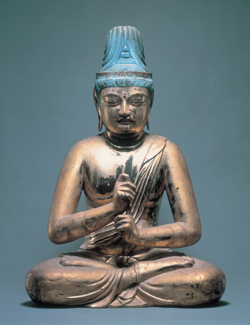
Important Cultural Property
Seated Dainichi Nyorai (Skt. Vairocana)
Heian period, dated 887 (Ninna 3)
Kongobuji
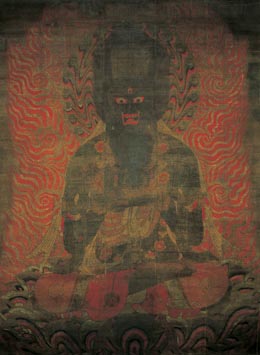
National Treasure
Five Bosatsu of Great Power: Kongoku Bosatsu
Hanging scroll
Heian period, 10th-11th century
Yushihachimanko
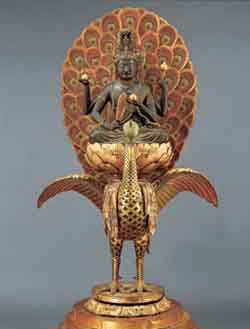
Important Cultural Property
Seated Figure of Kujaku Myo’o (Skt.
Mahamayuri)
By Kaikei
Kamakura period, dated 1200 (Shoji 2)
Kongobuji
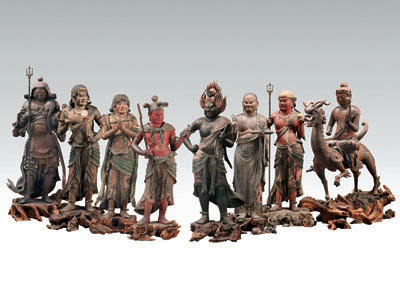
National Treasure
Figures of the Eight Attendants of Fudo Myo’o
(Skt. Acalanatha)
By Unkei
Kamakura period, 12th century(part,Nanbokucho period, 14th century)
Kongobuji
(Shitoku Doji,Eko Doji,Kongara Doji,Seitaka Doji,Ugubaga Doji,Shojobiku Doji,Eki Doji,Anokuta Doji)
3.- Diversity of Faith and Treasures
Established on the open plain of a mountaintop surrounded on all sides by numerous peaks, Koyasan was compared to the Cloister of the Central Dais with Eight Petals, which stood at the center of the Womb World Mandala. Since Kukai’s death, it has also been likened to the Pure Land paradises of Miroku (Maitreya) and Amida (Amitabha).
As demonstrated by the multitude of memorial stupas lining the path approaching the inner sanctuary of Okunoin, the site has also garnered the profound faith of countless people of all classes,from emperors and noblemen to samurai and commoners. Patrons donated various kinds of fine and decorative art objects, and Koyasan itself also gave birth to diverse Buddhist arts grounded in faith in Kukai’s teachings. Moreover, since Koyasan was distanced from the capital and isolated from the chaos of the secular world, many treasures from temples close to the capital were brought there to protect them from wartime destruction. It amassed so many valuable treasures that it has even been called the “Shosoin on the mountain.” These objects that have been carefully passed down to us today constitute an irreplaceable cultural heritage.
This section highlights various treasures of the decorative arts, such as the National Treasure Lacquered karabitsu-type legged case with design of plovers by the shore. It also presents new findings related to the Standing Figure of the Guardian Deity Shukongoshin (Skt. Vajrapani), which were discovered during later restoration work after dedicatory objects and an inscription were found inside the figure, solidly supporting an attribution to Kaikei and leading to the object’s recent designation as an Important Cultural Property.
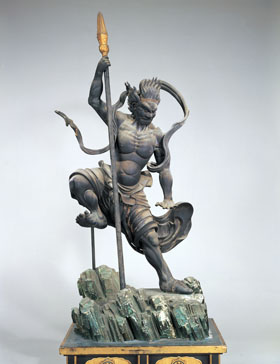
Important Cultural Property
Standing Figure of the Guardian Deity
Shukongoshin (Skt. Vajrapani)
By Kaikei
Kamakura period, dated 1197 (Kenkyu 8)
Kongobuji
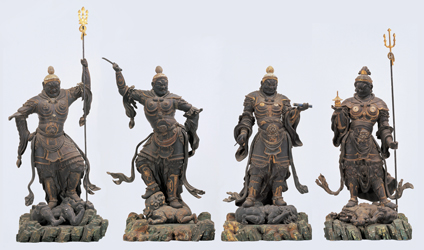
Important Cultural Property
Standing Figures of the Four Heavenly Kings
(Skt. Dhrtarastra)
By Kaikei
Kamakura period, 12th-13th century
Kongobuji
(Jikokuten (Skt. Dhrtarastra),Zochoten (Skt. Virudhaka),Komokuten (Skt. Virupaksa),Tamonten (Skt. Vaisravana))
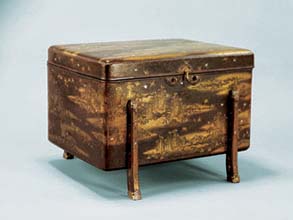
National Treasure
Lacquered karabitsu-type legged case with
design of plovers by the shore
Lacquer with maki-e sprinkled gold and mother-ofpearl
Heian period, 12th century
Kongobuji
*Unauthorized reproduction or use of texts or images from this site is prohibited.
2024 January
- Exhibition
- Closed
- Tea Ceremony
- Mon
- Tue
- Wed
- Thu
- Fri
- Sat
- Sun
- 1
- 2
- 3
- 4
- 5
- 6
- 7
- 8
- 9
- 10
- 11
- 12
- 13
- 14
- 15
- 16
- 17
- 18
- 19
- 20
- 21
- 22
- 23
- 24
- 25
- 26
- 27
- 28
- 29
- 30
- 31
2024 February
- Exhibition
- Closed
- Tea Ceremony
- Mon
- Tue
- Wed
- Thu
- Fri
- Sat
- Sun
- 1
- 2
- 3
- 4
- 5
- 6
- 7
- 8
- 9
- 10
- 11
- 12
- 13
- 14
- 15
- 16
- 17
- 18
- 19
- 20
- 21
- 22
- 23
- 24
- 25
- 26
- 27
- 28
- 29
2024 March
- Exhibition
- Closed
- Tea Ceremony
- Mon
- Tue
- Wed
- Thu
- Fri
- Sat
- Sun
- 1
- 2
- 3
- 4
- 5
- 6
- 7
- 8
- 9
- 10
- 11
- 12
- 13
- 14
- 15
- 16
- 17
- 18
- 19
- 20
- 21
- 22
- 23
- 24
- 25
- 26
- 27
- 28
- 29
- 30
- 31
2024 April
- Exhibition
- Closed
- Tea Ceremony
- Mon
- Tue
- Wed
- Thu
- Fri
- Sat
- Sun
- 1
- 2
- 3
- 4
- 5
- 6
- 7
- 8
- 9
- 10
- 11
- 12
- 13
- 14
- 15
- 16
- 17
- 18
- 19
- 20
- 21
- 22
- 23
- 24
- 25
- 26
- 27
- 28
- 29
- 30
2024 May
- Exhibition
- Closed
- Tea Ceremony
- Mon
- Tue
- Wed
- Thu
- Fri
- Sat
- Sun
- 1
- 2
- 3
- 4
- 5
- 6
- 7
- 8
- 9
- 10
- 11
- 12
- 13
- 14
- 15
- 16
- 17
- 18
- 19
- 20
- 21
- 22
- 23
- 24
- 25
- 26
- 27
- 28
- 29
- 30
- 31
2024 June
- Exhibition
- Closed
- Tea Ceremony
- Mon
- Tue
- Wed
- Thu
- Fri
- Sat
- Sun
- 1
- 2
- 3
- 4
- 5
- 6
- 7
- 8
- 9
- 10
- 11
- 12
- 13
- 14
- 15
- 16
- 17
- 18
- 19
- 20
- 21
- 22
- 23
- 24
- 25
- 26
- 27
- 28
- 29
- 30
2024 July
- Exhibition
- Closed
- Tea Ceremony
- Mon
- Tue
- Wed
- Thu
- Fri
- Sat
- Sun
- 1
- 2
- 3
- 4
- 5
- 6
- 7
- 8
- 9
- 10
- 11
- 12
- 13
- 14
- 15
- 16
- 17
- 18
- 19
- 20
- 21
- 22
- 23
- 24
- 25
- 26
- 27
- 28
- 29
- 30
- 31
2024 August
- Exhibition
- Closed
- Tea Ceremony
- Mon
- Tue
- Wed
- Thu
- Fri
- Sat
- Sun
- 1
- 2
- 3
- 4
- 5
- 6
- 7
- 8
- 9
- 10
- 11
- 12
- 13
- 14
- 15
- 16
- 17
- 18
- 19
- 20
- 21
- 22
- 23
- 24
- 25
- 26
- 27
- 28
- 29
- 30
- 31
2024 September
- Exhibition
- Closed
- Tea Ceremony
- Mon
- Tue
- Wed
- Thu
- Fri
- Sat
- Sun
- 1
- 2
- 3
- 4
- 5
- 6
- 7
- 8
- 9
- 10
- 11
- 12
- 13
- 14
- 15
- 16
- 17
- 18
- 19
- 20
- 21
- 22
- 23
- 24
- 25
- 26
- 27
- 28
- 29
- 30
2024 October
- Exhibition
- Closed
- Tea Ceremony
- Mon
- Tue
- Wed
- Thu
- Fri
- Sat
- Sun
- 1
- 2
- 3
- 4
- 5
- 6
- 7
- 8
- 9
- 10
- 11
- 12
- 13
- 14
- 15
- 16
- 17
- 18
- 19
- 20
- 21
- 22
- 23
- 24
- 25
- 26
- 27
- 28
- 29
- 30
- 31
2024 November
- Exhibition
- Closed
- Tea Ceremony
- Mon
- Tue
- Wed
- Thu
- Fri
- Sat
- Sun
- 1
- 2
- 3
- 4
- 5
- 6
- 7
- 8
- 9
- 10
- 11
- 12
- 13
- 14
- 15
- 16
- 17
- 18
- 19
- 20
- 21
- 22
- 23
- 24
- 25
- 26
- 27
- 28
- 29
- 30
2024 December
- Exhibition
- Closed
- Tea Ceremony
- Mon
- Tue
- Wed
- Thu
- Fri
- Sat
- Sun
- 1
- 2
- 3
- 4
- 5
- 6
- 7
- 8
- 9
- 10
- 11
- 12
- 13
- 14
- 15
- 16
- 17
- 18
- 19
- 20
- 21
- 22
- 23
- 24
- 25
- 26
- 27
- 28
- 29
- 30
- 31
2025 January
- Exhibition
- Closed
- Tea Ceremony
- Mon
- Tue
- Wed
- Thu
- Fri
- Sat
- Sun
- 1
- 2
- 3
- 4
- 5
- 6
- 7
- 8
- 9
- 10
- 11
- 12
- 13
- 14
- 15
- 16
- 17
- 18
- 19
- 20
- 21
- 22
- 23
- 24
- 25
- 26
- 27
- 28
- 29
- 30
- 31
2025 February
- Exhibition
- Closed
- Tea Ceremony
- Mon
- Tue
- Wed
- Thu
- Fri
- Sat
- Sun
- 1
- 2
- 3
- 4
- 5
- 6
- 7
- 8
- 9
- 10
- 11
- 12
- 13
- 14
- 15
- 16
- 17
- 18
- 19
- 20
- 21
- 22
- 23
- 24
- 25
- 26
- 27
- 28
2025 March
- Exhibition
- Closed
- Tea Ceremony
- Mon
- Tue
- Wed
- Thu
- Fri
- Sat
- Sun
- 1
- 2
- 3
- 4
- 5
- 6
- 7
- 8
- 9
- 10
- 11
- 12
- 13
- 14
- 15
- 16
- 17
- 18
- 19
- 20
- 21
- 22
- 23
- 24
- 25
- 26
- 27
- 28
- 29
- 30
- 31
2025 April
- Exhibition
- Closed
- Tea Ceremony
- Mon
- Tue
- Wed
- Thu
- Fri
- Sat
- Sun
- 1
- 2
- 3
- 4
- 5
- 6
- 7
- 8
- 9
- 10
- 11
- 12
- 13
- 14
- 15
- 16
- 17
- 18
- 19
- 20
- 21
- 22
- 23
- 24
- 25
- 26
- 27
- 28
- 29
- 30
2025 May
- Exhibition
- Closed
- Tea Ceremony
- Mon
- Tue
- Wed
- Thu
- Fri
- Sat
- Sun
- 1
- 2
- 3
- 4
- 5
- 6
- 7
- 8
- 9
- 10
- 11
- 12
- 13
- 14
- 15
- 16
- 17
- 18
- 19
- 20
- 21
- 22
- 23
- 24
- 25
- 26
- 27
- 28
- 29
- 30
- 31
2025 June
- Exhibition
- Closed
- Tea Ceremony
- Mon
- Tue
- Wed
- Thu
- Fri
- Sat
- Sun
- 1
- 2
- 3
- 4
- 5
- 6
- 7
- 8
- 9
- 10
- 11
- 12
- 13
- 14
- 15
- 16
- 17
- 18
- 19
- 20
- 21
- 22
- 23
- 24
- 25
- 26
- 27
- 28
- 29
- 30
2025 July
- Exhibition
- Closed
- Tea Ceremony
- Mon
- Tue
- Wed
- Thu
- Fri
- Sat
- Sun
- 1
- 2
- 3
- 4
- 5
- 6
- 7
- 8
- 9
- 10
- 11
- 12
- 13
- 14
- 15
- 16
- 17
- 18
- 19
- 20
- 21
- 22
- 23
- 24
- 25
- 26
- 27
- 28
- 29
- 30
- 31
2025 August
- Exhibition
- Closed
- Tea Ceremony
- Mon
- Tue
- Wed
- Thu
- Fri
- Sat
- Sun
- 1
- 2
- 3
- 4
- 5
- 6
- 7
- 8
- 9
- 10
- 11
- 12
- 13
- 14
- 15
- 16
- 17
- 18
- 19
- 20
- 21
- 22
- 23
- 24
- 25
- 26
- 27
- 28
- 29
- 30
- 31
2025 September
- Exhibition
- Closed
- Tea Ceremony
- Mon
- Tue
- Wed
- Thu
- Fri
- Sat
- Sun
- 1
- 2
- 3
- 4
- 5
- 6
- 7
- 8
- 9
- 10
- 11
- 12
- 13
- 14
- 15
- 16
- 17
- 18
- 19
- 20
- 21
- 22
- 23
- 24
- 25
- 26
- 27
- 28
- 29
- 30
2025 October
- Exhibition
- Closed
- Tea Ceremony
- Mon
- Tue
- Wed
- Thu
- Fri
- Sat
- Sun
- 1
- 2
- 3
- 4
- 5
- 6
- 7
- 8
- 9
- 10
- 11
- 12
- 13
- 14
- 15
- 16
- 17
- 18
- 19
- 20
- 21
- 22
- 23
- 24
- 25
- 26
- 27
- 28
- 29
- 30
- 31
2025 November
- Exhibition
- Closed
- Tea Ceremony
- Mon
- Tue
- Wed
- Thu
- Fri
- Sat
- Sun
- 1
- 2
- 3
- 4
- 5
- 6
- 7
- 8
- 9
- 10
- 11
- 12
- 13
- 14
- 15
- 16
- 17
- 18
- 19
- 20
- 21
- 22
- 23
- 24
- 25
- 26
- 27
- 28
- 29
- 30
2025 December
- Exhibition
- Closed
- Tea Ceremony
- Mon
- Tue
- Wed
- Thu
- Fri
- Sat
- Sun
- 1
- 2
- 3
- 4
- 5
- 6
- 7
- 8
- 9
- 10
- 11
- 12
- 13
- 14
- 15
- 16
- 17
- 18
- 19
- 20
- 21
- 22
- 23
- 24
- 25
- 26
- 27
- 28
- 29
- 30
- 31